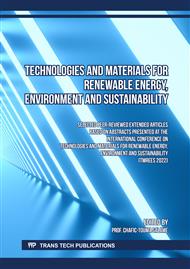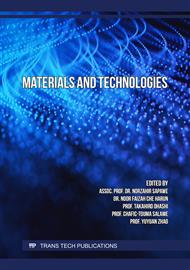[1]
H. Kvande, Occurrence and production of aluminium, in: Timothy P. Hanusa. The Lightest Metals: Science and Technology from Lithium to Calcium, John Wiley & Sons Ltd, Norway, 2015, p.1–10.
Google Scholar
[2]
M.J.K. Fawell, Aluminium in drinking-water: Background document for development of WHO guidelines for Drinking-Water Quality (GDWQ), (2010) 8–23.
Google Scholar
[3]
W.D. Menzie, J.J. Barry, D.I. Bleiwas, E.L. Bray, T.G. Goonan, G. Matos, The global flow of aluminum from 2006 through 2025. United States Geological Survey, (2010) 1–78.
DOI: 10.3133/ofr20101256
Google Scholar
[4]
S.S. Murugan, Mechanical properties of materials: Definition, testing and application, Int. J. Mod. Stud. Mech. Eng. 6 (2) 28–38.
Google Scholar
[5]
O. Gbenebor, M. Abdulwahab, O. Fayomi, A. Popoola, Influence of innoculant addition and cooling medium on the mechanical properties of AA 6063-type Al-Mg-Si alloy, Chalcogenide Letters, 9 (2012) 201–211.
Google Scholar
[6]
P.O. Babalola, C.A. Bolu, A.O. Inegbenebor, K.M. Odunfa, Development of aluminium matrix composites: A review 2 (2014) 1–11.
Google Scholar
[7]
P.O. Babalola, C. Bolu, A.O. Inegbenebor, O. Kilanko, S.O. Oyedepo, K.M. Odunfa, Producing AA1170 based silicon carbide particulate composite through stir casting method, Asian J. Mat. Chem. 2 (2017) 115–119.
DOI: 10.14233/ajmc.2017.ajmc-p49
Google Scholar
[8]
S. Nallusamy, J. Logeshwaran, Effect on aluminium metal matrix composite reinforced withnano sized silica particles, J. Metastable Nanocryst. Mat. 29 (2017) 25–34.
DOI: 10.4028/www.scientific.net/jmnm.29.25
Google Scholar
[9]
T. Rajmohan, K. Palanikumar, S. Arumugam, Synthesis and characterization of sintered hybrid aluminium matrix composites reinforced with nanocopper oxide particles and microsilicon carbide particles, Composites Part B: Eng. 59 (2014) 43–49.
DOI: 10.1016/j.compositesb.2013.10.060
Google Scholar
[10]
M.H. Rahman, H.M.M. Rashed, Characterization of silicon carbide reinforced aluminum matrix composites, Procedia Eng. 90 (2014) 103–109.
DOI: 10.1016/j.proeng.2014.11.821
Google Scholar
[11]
S.O. Akinwamide, S.M. Lemika, B.A. Obadele, O.J. Akinribide, B.T. Abe, P.A. Olubambi, Study of microstructural and mechanical properties of stir cast Al (SiC-Mg-TiFe) composite, Fluid Dynam. Mat. Proc. 15 (2019) 15–26.
DOI: 10.32604/fdmp.2019.04761
Google Scholar
[12]
M. Launey, R. Ritchie, On the fracture toughness of advanced materials, Advanced Materials, 21 (2009) 2103–2110.
DOI: 10.1002/adma.200803322
Google Scholar
[13]
M.F. Ibrahim, H.R. Ammar, A.M. Samuel, M.S. Soliman, F.H. Samuel, On the impact toughness of Al-15 vol.% B4C metal matrix composites, Composites Part B: Eng. 79 (2015) 83–94.
DOI: 10.1016/j.compositesb.2015.04.018
Google Scholar
[14]
P. Sri Ram Murthy, Y. Seetha Rama Rao, Impact on mechanical properties of hybrid aluminum metal matrix composites, Int. J. Eng. Adv. Tech. 8 (2019) 1638–1645.
Google Scholar
[15]
B. Dupen, Applied strength of materials for engineering technology, Applied Strength of Materials for Engineering Technology, 6 (2014) 152.
Google Scholar
[16]
G.B. Veeresh Kumar, R. Pramod, R. Hari Kiran Reddy, P. Ramu, B. Kunaal Kumar, P. Madhukar, M. Chavali, F. Mohammad, S.K. Khiste, Investigation of the tribological characteristics of aluminum 6061-reinforced titanium carbide metal matrix composites, Nanomaterials 11 (2021) 3039.
DOI: 10.3390/nano11113039
Google Scholar
[17]
J. Karloopia, Mozammil, S.P. Jha, Influence of in situ titanium diboride particulate reinforcement on mechanical properties of aluminum–silicon based metal matrix composites, JOM 72 (2020) 2927-2936.
DOI: 10.1007/s11837-020-04245-x
Google Scholar
[18]
R. Keshavamurthy, S. Mageri, G. Raj, B. Naveenkumar, P.M. Kadakol, K. Vasu, Microstructure and Mechanical Properties of Al7075-TiB 2 in-situ composite. Res. J. Mat. Sci. 1 (2013) 6–10.
Google Scholar
[19]
C. Suryanarayana, Microstructure : An Introduction, in: N. Eswara Prasad, R.J. Wanhill, Aerospace Materials and Material Technologies: Vol. 2, Springer, 2016, 105–123.
Google Scholar
[20]
P. Sharma, S. Sharma, D. Khanduja, A study on microstructure of aluminium matrix composites. J. Asian Ceram. Soc. 3 (2015) 240–244.
DOI: 10.1016/j.jascer.2015.04.001
Google Scholar
[21]
A. Kalkanlı, S. Yılmaz, Synthesis and characterization of aluminum alloy 7075 reinforced with silicon carbide particulates. Mat. Des. 29 (2008) 775–780.
DOI: 10.1016/j.matdes.2007.01.007
Google Scholar
[22]
A. Popoola, O. Olorunniwo, O. Ige, Corrosion resistance through the application of anti- corrosion coatings. In: Developments in Corrosion Protection, IntechOpen, 2014, pp.241-270.
DOI: 10.5772/57420
Google Scholar
[23]
R. Michalik, Influence of heat treatment on corrosion resistance of ZnAl40Ti2Cu alloy. Arch. Met. Mat. 63 (2018) 883–888.
Google Scholar
[24]
R.T. Loto, A. Adeleke, Corrosion of aluminum alloy metal matrix composites in neutral chloride solutions, J. Fail. Anal. Prev. 16 (2016) 874–885.
DOI: 10.1007/s11668-016-0157-3
Google Scholar
[25]
F. Toptan, A. Alves, I. Kerti, E. Ariza, L. Rocha, Corrosion and tribocorrosion behaviour of Al-Si-Cu-Mg alloy and its composites reinforced with B4C particles in 0.05 M NaCl solution, Wear, 306 (2013) 27–35.
DOI: 10.1016/j.wear.2013.06.026
Google Scholar
[26]
B. Bobić, S. Mitrović, M. Babić, I. Bobić, Corrosion of metal-matrix composites with aluminium alloy substrate, Trib. Ind. 32 (2010) 3–11.
Google Scholar
[27]
O.O. Joseph, K. Babaremu, Agricultural waste as a reinforcement particulate for aluminum metal matrix composite (AMMCs): A Review, Fibres 7 (2019) 33.
DOI: 10.3390/fib7040033
Google Scholar
[28]
P.O. Babalola, A.O. Inegbenebor, C.A. Bolu, S.I. John, Comparison of the mechanical characteristics of aluminium SiC composites cast in sand and metal moulds, Int. J. Mech. Eng. Tech 10 (2019) 1671-1681.
Google Scholar
[29]
E. Ananiadis, K.T. Argyris, T.E. Matikas, A.K. Sfikas, A.E. Karantzalis, Microstructure and corrosion performance of aluminium matrix composites reinforced with refractory high-entropy alloy particulates, Appl. Sci. 11 (2021) 1300.
DOI: 10.3390/app11031300
Google Scholar
[30]
M.B.R. Silva, V. Roche, T.M. Blanco, V.N. Hoang, O. Balancin, J.M. Cabrera, A.M.J. Junior, Effect of Processing Conditions on the Microstructure, Mechanical Properties, and Corrosion Behavior of Two Austenitic Stainless Steels for Bioimplant Applications, Metals 10 (2020) 1311.
DOI: 10.3390/met10101311
Google Scholar



